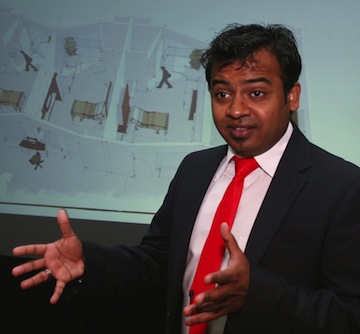Houston-based WHR Architects has named Lia Rodi, AIA, LEED AP, as the new curator of the firm’s Tradewell Fellowship Program, now in its 15th year. A past Tradewell Fellow, Rodi’s first official duty was the announcement of the 2012 Fellow Akshay Sangolli.
“It’s an honor to assume responsibility for the Tradewell program,” said Rodi. “Fourteen years ago, my own year as a Tradewell Fellow under the guidance of Kirk Hamilton was the ideal preparation for my new role. My experience and work with other Tradewells over the years has provided a model that will help to be of the best possible service to the Fellowship as a leader and mentor.”
Although internships are a tradition in the architectural profession, there are still few fellowships that offer recent graduates a focused opportunity to gain experience working closely with senior firm leaders and significant interaction with clients. This year’s Fellow, Akshay Sangolli, pursued the Tradewell in recognition of its exceptional nature. “It is a unique opportunity that puts you at an entirely different level at the outset of your career,” said Sangolli. “The Tradewell Fellowship offers [a] perfect combination of professional guidance, academic realization, and hands-on learning.”
The year-long Tradewell Fellowship was established by David Watkins, FAIA, president and chairman of WHR Architects, along with Kirk Hamilton, FAIA, FACHA, EDAC, now a professor at Texas A&M University and associate director for the Center for Health Systems and Design, in honor of the late Gary Tradewell, a former vice president and medical planner at WHR. The fellowship focuses on building careers of aspiring healthcare architects. Each year the Tradewell Fellow is involved with clients in early master planning and design, with a particular focus on healing environments and collaborative design methods as part of their employment at WHR. In addition to working directly with senior medical planners on design projects, Fellows receive career guidance from leaders at WHR and a network of past Tradewell Fellows.
In addition to project assignments, the Fellow also receives a scholarship to attend a healthcare architecture conference, and the opportunity to attend in-house educational presentations. Other educational opportunities include: assisting with teaching a graduate-level course on health facility planning, design, and construction; participating in evidence-based design activities; and assisting members of the firm in authoring speeches, articles, or books.
Fellows are selected by the group of past Tradewells at WHR, based on the strength of their design portfolios, letters of recommendation, and essays describing their accomplishments and career goals.
Sangolli, who began his fellowship in June, summarized his goals: “In the long term, I want explore how architecture can enhance human health, healing and well-being. I hope to participate in improving the quality of the built environment and its implications on human life around the world, especially in much-neglected developing nations.”
Related Stories
| Feb 15, 2011
Iconic TWA terminal may reopen as a boutique hotel
The Port Authority of New York and New Jersey hopes to squeeze a hotel with about 150 rooms in the space between the old TWA terminal and the new JetBlue building. The old TWA terminal would serve as an entry to the hotel and hotel lobby, which would also contain restaurants and shops.
| Feb 15, 2011
New Orleans' rebuilt public housing architecture gets mixed reviews
The architecture of New Orleans’ new public housing is awash with optimism about how urban-design will improve residents' lives—but the changes are based on the idealism of an earlier era that’s being erased and revised.
| Feb 15, 2011
LAUSD commissions innovative prefab prototypes for future building
The LA Unified School District, under the leadership of a new facilities director, reversed course regarding prototypes for its new schools and engaged architects to create compelling kit-of-parts schemes that are largely prefabricated.
| Feb 15, 2011
New 2030 Challenge to include carbon footprint of building materials and products
Architecture 2030 has just broadened the scope of its 2030 Challenge, issuing an additional challenge regarding the climate impact of building products. The 2030 Challenge for Products aims to reduce the embodied carbon (meaning the carbon emissions equivalent) of building products 50% by 2030.
| Feb 15, 2011
New Urbanist Andrés Duany: We need a LEED Brown rating
Andrés Duany advocates a "LEED Brown" rating that would give contractors credit for using traditional but low cost measures that are not easy to quantify or certify. He described these steps as "the original green," and "what we did when we didn't have money." Ostensibly, LEED Brown would be in addition to the current Silver, Gold and Platinum ratings.
| Feb 15, 2011
AIA on President Obama's proposed $1 billion investment in energy conservation
The President’s budget increases the value of investment in energy conservation in commercial buildings by roughly $1 billion, reports AIA 2011 President Clark Manus, FAIA. The significant increase from the current tax deduction of $1.80 per sq. ft. now on the books is an increase for which the AIA has been advocating in order to encourage energy conservation.
| Feb 14, 2011
Sustainable Roofing: A Whole-Building Approach
According to sustainability experts, the first step toward designing an energy-efficient roofing system is to see roof materials and systems as an integral component of the enclosure and the building as a whole. Earn 1.0 AIA/CES learning units by studying this article and successfully completing the online exam.
| Feb 11, 2011
Four Products That Stand Up to Hurricanes
What do a panelized wall system, a newly developed roof hatch, spray polyurethane foam, and a custom-made curtain wall have in common? They’ve been extensively researched and tested for their ability to take abuse from the likes of Hurricane Katrina.













